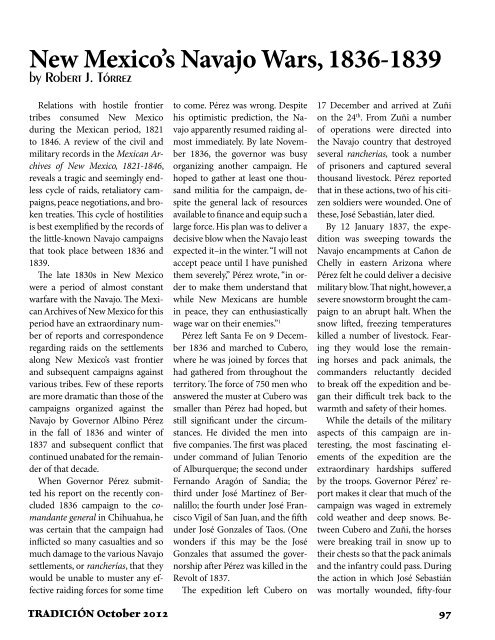tradicion revista fall 2012 - LPD Press & Rio Grande Books
tradicion revista fall 2012 - LPD Press & Rio Grande Books
tradicion revista fall 2012 - LPD Press & Rio Grande Books
You also want an ePaper? Increase the reach of your titles
YUMPU automatically turns print PDFs into web optimized ePapers that Google loves.
New Mexico’s Navajo Wars, 1836-1839<br />
by Robert J. Tórrez<br />
Relations with hostile frontier<br />
tribes consumed New Mexico<br />
during the Mexican period, 1821<br />
to 1846. A review of the civil and<br />
military records in the Mexican Archives<br />
of New Mexico, 1821-1846,<br />
reveals a tragic and seemingly endless<br />
cycle of raids, retaliatory campaigns,<br />
peace negotiations, and broken<br />
treaties. This cycle of hostilities<br />
is best exemplified by the records of<br />
the little-known Navajo campaigns<br />
that took place between 1836 and<br />
1839.<br />
The late 1830s in New Mexico<br />
were a period of almost constant<br />
warfare with the Navajo. The Mexican<br />
Archives of New Mexico for this<br />
period have an extraordinary number<br />
of reports and correspondence<br />
regarding raids on the settlements<br />
along New Mexico’s vast frontier<br />
and subsequent campaigns against<br />
various tribes. Few of these reports<br />
are more dramatic than those of the<br />
campaigns organized against the<br />
Navajo by Governor Albino Pérez<br />
in the <strong>fall</strong> of 1836 and winter of<br />
1837 and subsequent conflict that<br />
continued unabated for the remainder<br />
of that decade.<br />
When Governor Pérez submitted<br />
his report on the recently concluded<br />
1836 campaign to the comandante<br />
general in Chihuahua, he<br />
was certain that the campaign had<br />
inflicted so many casualties and so<br />
much damage to the various Navajo<br />
settlements, or rancherías, that they<br />
would be unable to muster any effective<br />
raiding forces for some time<br />
to come. Pérez was wrong. Despite<br />
his optimistic prediction, the Navajo<br />
apparently resumed raiding almost<br />
immediately. By late November<br />
1836, the governor was busy<br />
organizing another campaign. He<br />
hoped to gather at least one thousand<br />
militia for the campaign, despite<br />
the general lack of resources<br />
available to finance and equip such a<br />
large force. His plan was to deliver a<br />
decisive blow when the Navajo least<br />
expected it–in the winter. “I will not<br />
accept peace until I have punished<br />
them severely,” Pérez wrote, “in order<br />
to make them understand that<br />
while New Mexicans are humble<br />
in peace, they can enthusiastically<br />
wage war on their enemies.” 1<br />
Pérez left Santa Fe on 9 December<br />
1836 and marched to Cubero,<br />
where he was joined by forces that<br />
had gathered from throughout the<br />
territory. The force of 750 men who<br />
answered the muster at Cubero was<br />
smaller than Pérez had hoped, but<br />
still significant under the circumstances.<br />
He divided the men into<br />
five companies. The first was placed<br />
under command of Julian Tenorio<br />
of Alburquerque; the second under<br />
Fernando Aragón of Sandia; the<br />
third under José Martínez of Bernalillo;<br />
the fourth under José Francisco<br />
Vigil of San Juan, and the fifth<br />
under José Gonzales of Taos. (One<br />
wonders if this may be the José<br />
Gonzales that assumed the governorship<br />
after Pérez was killed in the<br />
Revolt of 1837.<br />
The expedition left Cubero on<br />
17 December and arrived at Zuñi<br />
on the 24 th . From Zuñi a number<br />
of operations were directed into<br />
the Navajo country that destroyed<br />
several rancherias, took a number<br />
of prisoners and captured several<br />
thousand livestock. Pérez reported<br />
that in these actions, two of his citizen<br />
soldiers were wounded. One of<br />
these, José Sebastián, later died.<br />
By 12 January 1837, the expedition<br />
was sweeping towards the<br />
Navajo encampments at Cañon de<br />
Chelly in eastern Arizona where<br />
Pérez felt he could deliver a decisive<br />
military blow. That night, however, a<br />
severe snowstorm brought the campaign<br />
to an abrupt halt. When the<br />
snow lifted, freezing temperatures<br />
killed a number of livestock. Fearing<br />
they would lose the remaining<br />
horses and pack animals, the<br />
commanders reluctantly decided<br />
to break off the expedition and began<br />
their difficult trek back to the<br />
warmth and safety of their homes.<br />
While the details of the military<br />
aspects of this campaign are interesting,<br />
the most fascinating elements<br />
of the expedition are the<br />
extraordinary hardships suffered<br />
by the troops. Governor Pérez’ report<br />
makes it clear that much of the<br />
campaign was waged in extremely<br />
cold weather and deep snows. Between<br />
Cubero and Zuñi, the horses<br />
were breaking trail in snow up to<br />
their chests so that the pack animals<br />
and the infantry could pass. During<br />
the action in which José Sebastián<br />
was mortally wounded, fifty-four<br />
TRADICIÓN October <strong>2012</strong> 97




